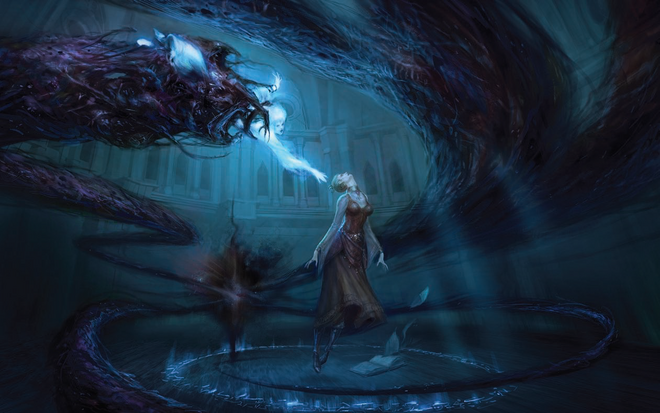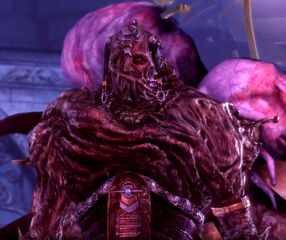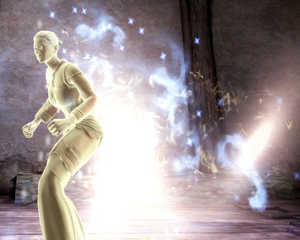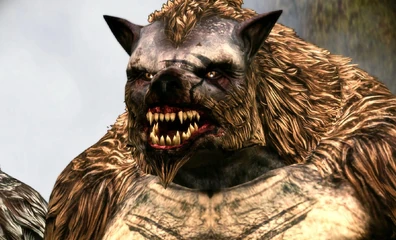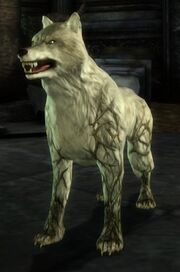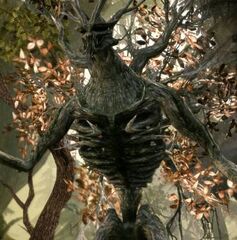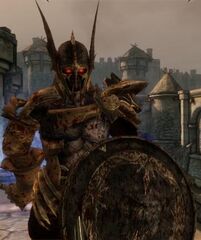- For the creature article, see Abomination (creature).
“It's like you're trapped in your own body, seeing out your eyes, while someone else moves you like a puppet. And you're trying to scream, to move a single muscle, but there's no escape. Until you look down at the blood on your hands...[1]”
An abomination is a creature created when a demon possesses and controls completely a living being with magical abilities.[2][3][4] There are stories of abominations that have ravaged entire settlements or even gone on to tyrannize a countryside for years after their creation.[5] Most of the world does not know, however, that the strength of an abomination depends entirely on the power of the demon that possesses the mage. Thus, the magnitude of threat an abomination can pose is dependent on the type of demon that possesses the mage.[6]
In the broadest sense of the term, "abomination" is sometimes used to refer to the demonic possession of mage corpses[2] or the product of merging a mage with a benevolent spirit.[7] The spirits can also possess almost any creature (living or dead) or object, including plants, animals,[8] and rocks; however, these hosts cannot become abominations in the true sense, as the spirits gain no additional powers through possession.[9] The term abomination is also used in popular stories and books to indicate the demonic possession of living beings without magic.[10]
While those who possess a mage may utilize the versatile magic that a mage's magic can provide, all possessed creatures can be augmented by the magical abilities that a spirit or demon can provide. Like all possessed creatures, the strength of the demon or spirit and what kind of magical abilities it can provide its vessel depends entirely on the type of spirit or demon that is inhabiting its host. For example, according to Enchanter Brahm's categorization of demons, Rage demons exhibit great strength and occasionally the ability to generate fire; but they expend their energies quickly and are prone to violent outbursts on the living. A rage demon can possess a mage and become physically stronger and cast fire magic, or it can possess a wolf or a non-magical human host and transform it into a Werewolf—humanoid monsters with incredible speed and strength, able to spread a curse to those they bit that would drive them mad with unthinking fury.[11]
In contrast, a Desire demon is very intelligent, exploiting the desires of people as its name suggests, and may grant its vessel the ability to control minds and conjure illusions. Pride demons are the strongest of demons and considered most dangerous. Pride demons possess vast intellect and are masters of magic. They are true schemers who seek most strongly to possess mages, and will bring other demons across the Veil.[6]
Background[]
Abominations are rare and usually created when a weak mage enters the Fade and is exposed to a demon's influence,[2] such as during the ritual of Harrowing employed by the Circle of Magi. Mages who experiment with blood magic are more susceptible to demons and also risk becoming abominations.[12] It is not unheard of for Grey Warden mages trapped by darkspawn behind enemy lines with no hope of rescue or reinforcements to willingly surrender themselves to demons and become abominations in order to slay as many darkspawn as possible.[13] Malicious blood mages and demons in solid form are also able to summon demons into unwilling hosts.[14]
Once a demon possessed abomination is created, it will try to create more abominations.[2][3] The mages who are not yet fully possessed can be saved by using the Litany of Adralla.[2]
While it is possible to free someone who has been possessed, this is rarely done due to the risks involved in such an attempt. One method involves an independent party entering the Fade and killing the dominating demon of the possessed.[15] Marethari Talas says that those who are freed in such a way never truly recover as the soul of the formerly possessed is scarred and describes the liberated host as a wounded animal that could easily fall prey to scavengers. The Avvar employ a ritual to release themselves from possession but this ritual involves a spirit voluntarily leaving its host rather than fighting off a demon.[16]
Aside from those listed, death of the host is the most convenient way to end possession.
The possession is not physical—the demon is still in the Fade, but so is the mage's spirit, and the demon is able to control the body through that captive spirit like a puppet. The demon channels its power through the body, sees through the mage's eyes and is able to use magic in ways the mage would have never imagined. However, the experience of entering the physical realm is overwhelming to the weaker demons, and abominations are often driven mad by the unfamiliar sensations, turning into monstrosities and going on a rampage.[5] The most powerful demons are able to adapt to the new form and even maintain the original physical shape of their host in particular, when the possession is accepted willingly. Some demons also have the ability of shapeshifting. The most common way to get an abomination to reveal its nature (often causing the sentient host to transform into a grotesque, demonic form[19]) is to make it feel threatened so that the residing demon would impulsively defend its host.[20] The Avvar claim that the benevolent spirits they worship as gods watch for signs that an abomination has turned dangerous, and if that happens, the abomination is killed in its sleep before it can endanger others.[16]
As stated, possession can occur with either a spirit or a demon and thus the possession experience varies. In some cultures across Thedas, mages deliberately seek out possession by spirits. Avvar apprentice mages allow themselves to become possessed by spirits to learn to control their magic, then release the spirit once they have mastered their talent.[21] The seers of Rivain, wise women who are in fact hedge mages, also communicate with spirits and allow themselves to become possessed.[22]
Notable abominations[]
Dragon Age: Dawn of the Seeker[]
- Frenic – possessed by a pride demon
Dragon Age: The Calling[]
Dragon Age: Origins[]
- Amalia – possessed by a desire demon (conditional}
- Connor Guerrin – possessed by a desire demon (conditional}
- Flemeth
- Gaxkang[23]
- Matthias – possessed by a desire demon (conditional}
- Slavren – a lieutenant of the Sloth demon
- Sophia Dryden
- Uldred – possessed by a pride demon
- Witherfang – possessed by The Lady of the Forest
- Wynne – possessed by a Spirit of Faith
Dragon Age: Awakening[]
- The Baroness – possessed by a pride demon
- Kristoff – possessed by a spirit of Justice
Dragon Age Legends[]
- Khedra – possessed by a pride demon
Dragon Age II[]
- Anders – possessed by a spirit of Justice; possibly corrupted into Vengeance
- Grace – possessed by a pride demon
- Evelina
- Feynriel – possessed by the sloth demon Torpor (conditional)
- Marethari Talas – possessed by the pride demon Audacity
- Olivia
- Orsino
- Wilmod
Dragon Age: Asunder[]
- Evangeline de Brassard – possessed by a Spirit of Faith
- Pharamond
Dragon Age: The Masked Empire[]
Dragon Age: The Last Court[]
Dragon Age: Inquisition[]
- Grandin – possessed by a rage demon
- Gurd Harofsen
- Sigrid Gulsdotten
Dragon Age: Tevinter Nights[]
- Ambrose Forfex[24]
- Renke[25] – a werewolf created by a hunger demon possession
Dragon Age: Absolution[]
Other[]
- Mythallen – a Dalish elf named Harralan who was possessed by a rage demon
- Revenger – possessed by a rage demon
Variations[]
- Rage abomination
- Sloth abomination
- Hunger abomination
- Desire abomination
- Pride abomination
The broader definition also includes:
- Arcane horrors – mage corpses possessed by pride demons
- Cannibals – living hosts possessed by hunger demons[6]
- Fanged skeletons – corpses possessed by hunger demons
- Revenants – warrior corpses typically possessed by powerful desire or pride demons
- Shambling skeletons – corpses possessed by sloth demons
- Spirit Warriors – humans and elves that employ magical abilities but are not mages; instead, they flirt with inhabitants of the Fade who agree to augment mortal abilities in exchange for a glimpse of the physical world
- Sylvans – trees possessed by rage demons or intelligent spirits
- Werewolves – humans, elves and wolves possessed by either rage or hunger demons
- Vampires – living hosts possessed by hunger demons[6]
Codex entries[]
 Codex entry: Abomination
Codex entry: Abomination Codex entry: Blighted Werewolf
Codex entry: Blighted Werewolf Codex entry: Demonic Possession
Codex entry: Demonic Possession Codex entry: Flemeth
Codex entry: Flemeth Codex entry: Flemeth's Demise
Codex entry: Flemeth's Demise Codex entry: The Right of Annulment
Codex entry: The Right of Annulment Codex entry: Scrolls of Banastor
Codex entry: Scrolls of Banastor Codex entry: Werewolf
Codex entry: Werewolf
Gallery[]
References[]
- ↑ Conversation between Anders and Merrill.
- ↑ 2.0 2.1 2.2 2.3 2.4
 Dragon Age: The World of Thedas, vol. 1, p. 172
Dragon Age: The World of Thedas, vol. 1, p. 172
- ↑ 3.0 3.1 Codex entry: Abomination
- ↑ Heroes of Dragon Age: The Circle Tower, Uldred's Turn
- ↑ 5.0 5.1 Mike Searly. "Traveler's Guide". Dragon Age: Origins: Collector's Edition: Prima Official Game Guide.
- ↑ 6.0 6.1 6.2 6.3 Codex entry: Demonic Possession
- ↑ Wynne is called an abomination in Dragon Age: Asunder, p. 270
- ↑ Codex entry: Wild Sylvan
- ↑
 David Gaider. "Can non-mages become abominations?" . The BioWare Forum. Retrieved on August 18, 2013.
David Gaider. "Can non-mages become abominations?" . The BioWare Forum. Retrieved on August 18, 2013.
- ↑ Brother Genitivi writes about wolves possessed by rage demons as a sort of abominations.
- ↑ Codex entry: Werewolf
- ↑
 Dragon Age: The World of Thedas, vol. 1, p. 109
Dragon Age: The World of Thedas, vol. 1, p. 109
- ↑ Dragon Age: Last Flight, p. 123
- ↑ As evidenced by Cullen Rutherford's dialogue during Enemies Among Us.
- ↑ The Arl of Redcliffe#What to do with Connor
- ↑ 16.0 16.1 Conversations with The Augur of Stone-Bear Hold.
- ↑ According to Keeper Marethari Talas' dialogue during A New Path
- ↑ According to Anders' dialogue during The Last Straw should you execute him
- ↑ As evidenced by fights with a possessed Amalia, Wilmod, Marethari Talas and Uldred
- ↑ According to Anders during Enemies Among Us.
- ↑ As seen during the side quest In Exile.
- ↑ Codex entry: Rivain
- ↑ Codex entry: Unbound
- ↑ Dragon Age: Tevinter Nights, The Wigmaker Job
- ↑ Dragon Age: Tevinter Nights, Hunger
| ||||||||||||

